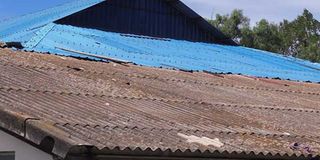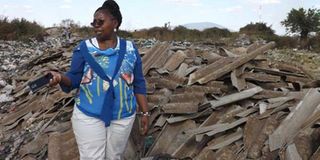
A building at Nanyuki High School with asbestos roofing which Nema wants replaced with iron sheets saying it poses health risks to students and teachers.
The plan to dispose of 32,000 tonnes of asbestos without following World Health Organisation guidelines could have “Nagasaki atomic bomb-like” effects on millions of urban dwellers in Kenya.
Senior National Environment Management Authority (Nema) staff are reportedly not happy after President William Ruto and his Cabinet Secretary for Environment (until Wednesday), Aden Duale, directed the agency and devolved governments to demolish asbestos-roofed buildings.
They say the order was given without considering the health, economic, social and environmental ramifications.
Civil engineers in the UK and South Africa say Kenya is hurtling towards a disaster that might last a century.
There are even fears that grabbers are using asbestos as an excuse to get public land.
“Asbestos poses no immediate threat. It is not harmful when not disturbed. The directive will unleash a chain reaction that will be felt for decades,” said Dr Lawson Kamau Mbuguss, a UK-based engineer and economist.
Nairobi, Mombasa, Kisumu, Nakuru, Thika and former provincial capitals – many of them now county headquarters – have a high number of government houses lined up for demolition to create room for the controversial “affordable” housing programme.
Says Dr Kamau: “Asbestos roofing sheets were widely used due to their durability and fire resistance. When disturbed, asbestos fibres become airborne and can pose health risks. The health hazards from asbestos exposure include mesothelioma – a rare, aggressive cancer affecting the lining of the lungs, abdomen or heart.”

Asbestos roofing on buildings housing the Meru County Directorate of Environment.
“There is also asbestosis, which is the scarring of the lung tissue, leading to breathing difficulties. Lung cancer is directly linked to asbestos exposure. Pleural thickening, described as inflammation and thickening of the lung lining, restricts lung function. Since asbestos-related diseases often take years or decades to manifest, proper removal procedures are critical to preventing long-term health complications.”
In London, where he lives, there are asbestos-roofed buildings that are more than a century old.
“Even my offices have asbestos roofing. Should need arise to demolish them, people in the five-kilometre radius would have to be evacuated. They are to be accommodated in safe houses and provided with the basic amenities for up to six months,” Dr Kamau says.
Dr Ruto directed county governments to take charge of the demolitions.
While the Executive and the Ministries of Environment and Housing sound bullish about the prospect of creating space for the housing project, Nema believes Kenya is on the cusp of an ecological and health disaster if the populist agenda prevails over pragmatism informed by scientific-based evidence.
A Nema manager told the Weekly Review that asbestos is a health hazard, but added that the matter needs to be addressed scientifically to achieve the desired outcome.
“Asbestos was promoted many years ago. It has now come to our knowledge that it could be the reason for the cancer upsurge. Water from asbestos roofs is poisonous. But how aware is the community?” asked the manager who sought anonymity.
Public education and awareness on the dangers posed by that material are low. This can be attributed to staffing shortages.
Prof A.A Talukhaba, a construction economics specialist at Tshwane University of Technology in Pretoria, admits that asbestos in buildings is a danger to health.
He says age leads to the wear and tear of asbestos products. It is even more hazardous when old buildings with asbestos components are demolished as the release of fibres increases.

Kiambu County Executive Member for Water and Environment Esther Njuguna shows the asbestos waste that was dumped in the open near residential estates in Thika.
Asked about the directive in Kenya, Prof Talukhaba said: “Asbestos cannot be demolished the same way we do with other products. It has to be removed in a proper and controlled way. If the process is on a large scale where many people are involved, evacuation is necessary.”
“The other option is to provide personal protective equipment to the workers and the affected residents. A huge campaign is necessary to inform people on the dangers. Protecting the affected people to global standards is neither easy nor cheap.”
The Nema manager says the directive could lead to the unleashing of dangerous material whose impact will be similar to the disposal of nuclear waste in Marsabit in the 1980s.
The experts fear the country is likely to witness a sharp rise in pregnancy miscarriages.
“Let’s refer to the Constitution. Some functions being handled by Nema are devolved, while others are still with the national government. We need to find a consensus on how to handle this,” the manager said.
Rural and Urban Private Hospitals Association founder Brian Lishenga talks of an exponential rise in cancer cases should the directive be implemented.
Former Group Managing Director of Pathologists Lancet Kenya and the Lancet Group of Laboratories East Africa, Ahmed Kalebi, says Kenya “appears hell-bent on transferring asbestos from rooftops to the environment”.
“Getting rid of asbestos is good. However, if it is not disposed of properly, there will be serious health problems,” Dr Kalebi told the Weekly Review.

Nakuru Primary School in Nakuru East whose roof is made of asbestos, which researchers say can increase the risk of lung cancer.
“There is no clarity on the demolitions and disposal of the asbestos products. If the asbestos is taken to ordinary landfills, it will end up in the bodies of street families who go there for food and items for sale. Animals like cats, dogs and birds will also come into contact with the asbestos.”
Prof Talukhaba says many countries, including South Africa, have strict policies and regulations on how to handle asbestos.
“It starts with identification, removal and disposal. It is done by experts,” he said.
Mr Duale acknowledged the complexity of the exercise and promised to respond after a meeting on Tuesday.
“Call me after the meeting. I will give you a more comprehensive answer,” the minister promised.
He did not respond to calls thereafter. Mr Duale was transferred to the Health Ministry on Wednesday.






